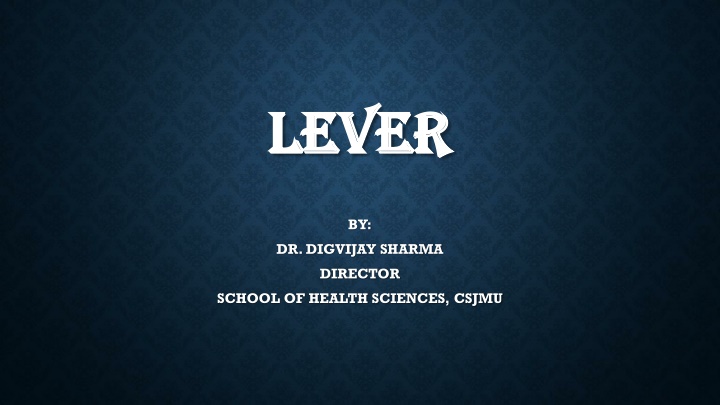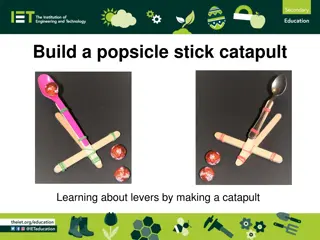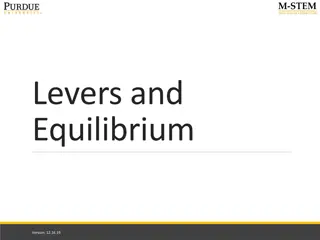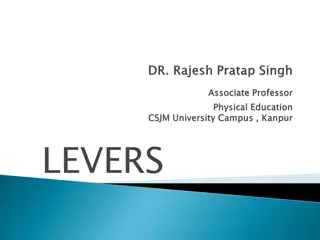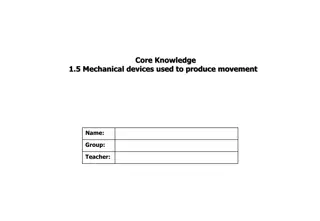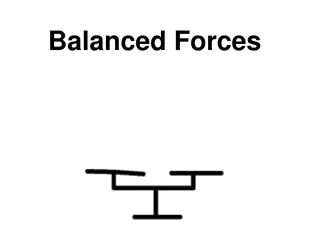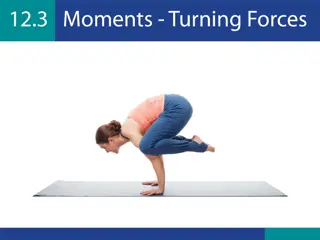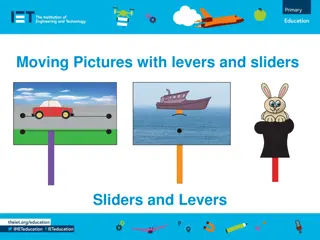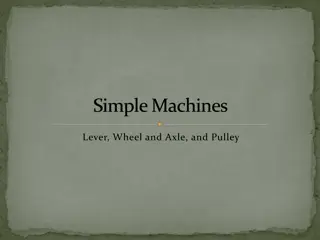Levers and Their Application
A lever is a simple machine with a fixed point called a fulcrum that enables work to be done by applying effort at one point to lift a weight. There are three classes of levers based on the positions of the fulcrum, effort, and weight, each with specific characteristics. Levers in the human body are bones that function similarly to mechanical levers. Explore the different types of levers, their applications, and how they operate in both mechanical and biological systems.
Download Presentation

Please find below an Image/Link to download the presentation.
The content on the website is provided AS IS for your information and personal use only. It may not be sold, licensed, or shared on other websites without obtaining consent from the author.If you encounter any issues during the download, it is possible that the publisher has removed the file from their server.
You are allowed to download the files provided on this website for personal or commercial use, subject to the condition that they are used lawfully. All files are the property of their respective owners.
The content on the website is provided AS IS for your information and personal use only. It may not be sold, licensed, or shared on other websites without obtaining consent from the author.
E N D
Presentation Transcript
LEVER LEVER BY: DR. DIGVIJAY SHARMA DIRECTOR SCHOOL OF HEALTH SCIENCES, CSJMU
DEFINITION DEFINITION A lever is a rigid bar which is capable of movement about a fixed point called a Fulcrum Work is done when a force or effort (E) applied at one point on the lever, acts upon another force or weight (W). The perpendicular distance from the fulcrum to the effort Is called effort arm and from fulcrum to weight as weight s arm. There are three orders or classes of lever which is characterised by the relative positions of fulcrum, effort and weight.
LEVER AND HUMAN BODY LEVER AND HUMAN BODY In the body, lever is represented by a bone which is capable of movement about a fulcrum formed of an articulating surfaces at joints, the effort by the muscle s contraction applied at the point of insertion to the bone While the weight may be either at the COG of the part moved or the object to be lifted
FIRST ORDER LEVER FIRST ORDER LEVER In this type of levers, the fulcrum is in between the effort and weight. The length of the effort s arm and weight s arm may be equal or one may exceed the other in length. There may be three cases for such levers: Weight Arm = Effort Arm Weight Arm > Effort arm Weight Arm < Effort arm
FIRST ORDER LEVER IN HUMAN BODY FIRST ORDER LEVER IN HUMAN BODY
SECOND ORDER LEVER SECOND ORDER LEVER In this type of lever, the weight is in between the fulcrum and the effort. Effort s arm must therefore always exceed the weight s arm Effort arm > Weight arm
SECOND ORDER LEVER IN HUMAN BODY SECOND ORDER LEVER IN HUMAN BODY
THIRD ORDER LEVER THIRD ORDER LEVER In this type of lever, the effort is in between the fulcrum and the weight Weight s arm must therefore exceed the effort s arm Weight s arm > Effort s arm
THIRD ORDER LEVER IN HUMAN BODY THIRD ORDER LEVER IN HUMAN BODY
MECHANICAL ADVANTAGE MECHANICAL ADVANTAGE It is the ratio of weight to the effort. MA= Weight/ Effort or MA= Effort Arm/ Weight Arm The efficacy of the levers depends upon two factors: i. force exerted, i.e., Weight or Effort ii. Weight s arm or effort s arm The product of two factors called moment of force or Torque
CASE 1 MECHANICAL ADVANTAGE CASE 1 MECHANICAL ADVANTAGE When Effort s arm = Weight s arm An effort of a magnitude equal to weight will require to lift. So no advantage is gained but the machine is useful for measuring weight For example when there is a weight of 10 kg with weight arm of 20 cm and effort of 10 kg with effort arm of 20 cm it describes a state of equilibrium An example of this is the Common balance
CASE 2 MECHANICAL ADVANTAGE CASE 2 MECHANICAL ADVANTAGE When Effort s arm > Weight s arm Then less effort is required to lift the object and advantage will be gained This is known as Mechanical advantage and it is obtained in levers of 1st order when fulcrum is nearer to weight and all levers of second order It is never seen in levers of third order For example, when there is a weight of 10 kg with weight s arm of 20 cm and effort of 5 kg with effort arm of 40 cm length then Mechanical advantage calculated will be approx. 2
CASE 3 MECHANICAL ADVANTAGE CASE 3 MECHANICAL ADVANTAGE When Effort s arm < Weight s arm In this case where there is shorter effort arm then mechanical disadvantages occur As in 1st order lever when F is nearer to effort and all lever of third order
